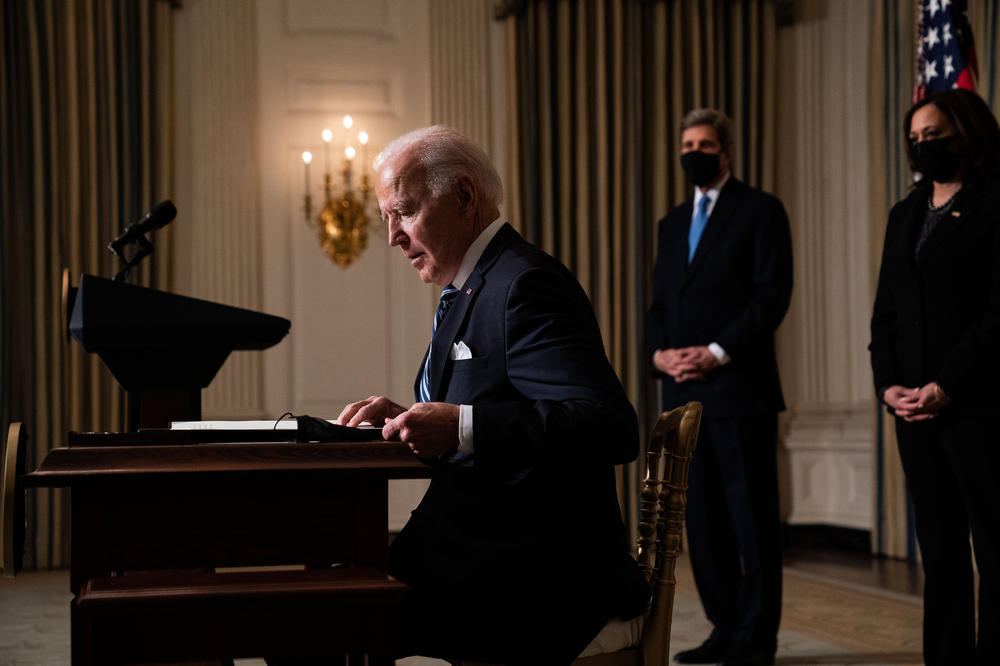Section Branding
Header Content
How Fast Will Biden Need To Move On Climate? Really, Really Fast
Primary Content
In a flurry of first-week executive orders, President Biden sent a definitive message that his administration would move faster on climate change than any before. Now, the question is whether it will be fast enough.
Scientists warn that the coming decade will be critical for slowing heat-trapping emissions, potentially keeping average annual global temperatures from rising more than 1.5 degrees Celsius compared to the mid-19th century. Right now, the world is on track for an increase of 3 degrees Celsius, a level that ensures more destructive wildfires and hurricanes, devastation for coral reefs and rising seas flooding the coastlines.
Biden has set a goal of making the U.S. carbon neutral by 2050, which will require steeper emissions cuts than the U.S. has ever achieved. To reach it, coal power would have to wane into a footnote, replaced by renewables like solar and wind. Most cars would run on batteries, instead of gas. He has also emphasized investing in communities that are hardest hit, both communities of color that bear the highest pollution burden and those that depend on disappearing fossil fuel jobs.
"We need to increase tree cover five times faster than we are," said John Kerry, Biden's special envoy for climate. "We need to ramp up renewable energy six times faster. And the transition to electric vehicles needs to take place at a rate 22 times faster."
Prevailing winds are blowing in Biden's direction. Renewable energy is increasingly cheaper and, along with a glut of natural gas, is driving coal power plants to retire. States and companies are pursuing their own goals to cut emissions.
Still, reversing the Trump administration's environmental rollbacks could potentially take years. The administration will also need the cooperation of Congress to dramatically increase investment in climate policies. Biden says even without Congress, climate will be a priority across all federal agencies.
"To me, that suggests that it's not just a campaign promise, but that the administration is really committed to achieving this goal," says Angel Hsu, assistant professor at University of North Carolina at Chapel Hill. "That said, it's very easy to make these types of goals and pledges. The hard part really comes in the follow through."
What's working in Biden's favor
Early in the Trump administration, officials took aim at one of former President Barack Obama's key climate policies: limits on emissions from the dirtiest power plants, a policy known as the Clean Power Plan.
Trump rolled back the plan, but emissions from power plants have still fallen. Despite Trump's support for the coal industry, it's continued to shrink.
"Coal-fired power plants are just uneconomic and are continuing to retire," says Dan Lashof, director of the World Resources Institute. "But much of the power from coal plans has been replaced by natural gas-fired power plants, and we need to start making that transition away from gas. And that means doubling or tripling the pace at which we're building wind and solar over the next decade."
Renewables are increasingly becoming the most affordable option for electric utilities. Biden is seeking to speed up that trend by investing in clean energy projects through economic recovery spending, as a way of supporting both job creation and climate goals.
Climate policies have also been alive and well in many states across the country, which have passed their own goals on energy efficiency, cleaner cars and renewable energy.
"That's really encouraging that we've had non-federal action on climate change the last fours, despite there being no action at the national level and even reversal," Hsu says. "Even states that you wouldn't expect like Louisiana, just a couple months ago, set a target to decarbonize."
As carbon dioxide pollution from power plants fell, transportation became the country's largest source of greenhouse gases. The Obama administration instituted fuel economy standards that required automakers to improve their efficiency by 5% every year. The Trump administration replaced that with just 1.5% improvements annually.
Prior to Trump arriving in office, California and 13 other states pioneered their own tougher standards on tailpipe emissions from cars and trucks. The states' authority to have their own rules hinges on California's "waiver," special permission granted 40 years ago by the federal government for the state to set separate car pollution standards. Trump sought to revoke California's waiver, which the state challenged as being illegal under the Clean Air Act.
While that legal battle was playing out, four automakers took California's side, agreeing to meet tougher standards than the Trump administration's fuel economy rules. Even General Motors, which had supported the Trump administration, just announced it would plan to sell all zero-emission cars by 2035.
With electric cars booming in overseas markets, economic forces are pushing automakers to speed up the rollout. Biden will seek to usher it along by installing half a million new charging stations domestically and by making the government's fleet of cars all-electric.
What's working against Biden
On his first day in office, Biden took direct aim at more than 100 Trump-era environmental policies, ordering federal agencies to review and replace them. Many are critical to cutting emissions in the U.S., like limiting emissions of methane from oil and gas wells, a significant source of the potent heat-trapping gas.
Still, that process is likely to take years. Many regulations, like the federal fuel economy rules for cars and trucks, require a lengthy rulemaking process with scientific analysis and public comment. As a result, many of the Trump administration's rules only went into effect in his last year in office.
Even after that, Biden's environmental rules are likely to be challenged by lawsuits, potentially reaching the Supreme Court and adding years to the process. Future administrations could also undo those rules, just as the Trump administration did.
That has some looking to Congress for meaningful climate action, since laws passed there have better sticking power and spending power.
"Ideally, we would have a federal clean electricity standard that would require a steady reduction in emissions to get us to 100% clean power by 2035," says Lashof. "It's unclear whether the votes will be there in Congress."
A high-profile climate bill would test the Democrats' razor-thin margin in the Senate, where support from party conservatives like Sen. Joe Manchin of West Virginia would be hard won. Instead, Democrats may look to add climate policies to other bills or pass them through the arcane budget process.
"There's a lot of acrimony that you can see in Congress and where we're sitting right now, it's probably hard to see a big bipartisan bill on climate change," says Greg Dotson of the University of Oregon, who also worked on energy policy in the U.S. House of Representatives. "But I don't think that means you stop trying in Congress. Maybe it's tax policy. Maybe it's investment decisions. Maybe it's budgetary issues."
For now, the Biden administration is focusing on executive actions, like banning new oil and gas leases on federal lands and revoking permits for the Keystone XL pipeline, which would have carried carbon-intensive oil from Canada.
"Certainly we're going to look at congressional action," Gina McCarthy, Biden's domestic climate advisor, told NPR. "But right now, we can use the strength of the federal budget and our procurement opportunities to send the right market signals on the kind of technologies and products that we think we need and we know we have available now that are cost-effective and that, again, grow jobs."
The Biden administration's climate ambitions will become clearer this spring when it releases new U.S. commitments for cutting emissions under the Paris climate agreement. Biden announced the U.S. would rejoin the accord on his first day in office, after the Trump administration pulled out and ceased engaging in the international effort.
Biden says the U.S. will come back to the table at a key moment, when countries are making new commitments to cut emissions under the Paris accord. Now, he has to convince them he can deliver.
Copyright 2021 NPR. To see more, visit https://www.npr.org.


